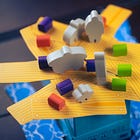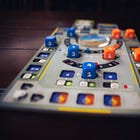As we near the end of 2024, I find myself reflecting on the year gone by and examining my writing, especially as I plan for the next two or so months of this newsletter. (I try not to figure everything out the night before. This isn’t a college philosophy course. I should know — I took a bunch of them and loved it, but I was always bad at starting my papers at a reasonable time.)
It’s with that attitude that I re-read my look at my favorite games from 2023. I wondered — what games did I miss from 2023? There’s a certain difficulty in year-end lists, if just because great games can be released at nearly any point in the year, and a game dropping in November shouldn’t exclude it from consideration. It often does, though, if just because it takes time to get games to the table.
So, here I am, with seven great games from 2023 that I didn’t feature in my “Best games of 2023” piece. I hope it doesn’t feel too out of the blue. There are even more great games from 2023 I haven’t played, and I’ll talk about a few of those, too. (I could probably do this for 2020 through 2022, but I’m not trying to look back too far here.)
Rafter Five
I love a dexterity game, despite my not being very good at them. I think that’s well-established canon here at Don’t Eat the Meeples, but that hasn’t stopped me from talking about them constantly for a long while. There’s something so delightful and funny about trying to do something physical and failing. When I’m playing Tokyo Highway and I collapse the city’s infrastructure on itself, it’s the gaming equivalent of slipping on a banana peel: comedy gold.
Rafter Five is full of those moments. It’s a game that shouldn’t work. The premise is simple: You and your opponents are on a raft, and presumably because you were abandoning a ship full of treasure, you’ll be trying to carry those valuables back to shore — and you want to be the only one remaining. I think this is a game about pirates. (Sorry, Long John — buccaneers.)
The premise is simple, and the game is deceptively simple, too. Rafter Five comes with a bunch of planks with which you’ll expand your raft, but those planks are just thin cards. The treasure you’re trying to place on the ship is a collection of small wooden chests. And the raft? The raft is the top half of the game box, which is placed on the bottom half of the game box. Boxes as components — I love it.
On your turn, you’ll be lifting a rafter (a rafter in this game being one who is on a raft, not a part of a building structure), placing a plank, replacing the rafter, and placing one of your treasure chests somewhere on the new plank. If you knock off other players’ treasure five times, the game ends, and you’re the sole loser.
I’m telling you, this game rules — the plank cards hold the weight of the treasure chests far better than you’d anticipate, and once somebody tries to place a piece dangling nearly entirely over the precipice, everyone else is going to do it, too. That’s magic, right there.
Designed by Mashiu and Jun Sasaki, published by Oink Games. Rafter Five plays 1 to 6 players.
Sky Team
Sky Team is a game that takes an exciting theme — piloting a commercial aircraft — and makes it even more exciting. Commercial air travel is, after all, one of the safest ways to travel, but you might think otherwise if you spend enough time with Sky Team. Icy runways, tailwinds and headwinds, interns, failed engines — the list goes on. It’s a cooperative game played in silence punctuated by between-round coordination.
Sky Team is one of my favorite games of 2023, and one I didn’t play that year. It did come out late in the year, though honestly, it doesn’t matter when you play a great game — it could be the year it came out, it could be 50 years later. It doesn’t diminish the game, and it shouldn’t diminish your experience. (I do wonder, though — what will game design look like in 50 years? Will the games of today be looked back at with the same attitude with which we look at games from the 1970s?)
I should also say that Sky Team has rocketed to the top of my favorite-cooperative-games list that I sort of keep in my head. It has a slightly different place on that list than most, simply because it’s only for two players, and there are so few amazing games geared only for two. When I praised Sky Team earlier in the year, I focused a lot on how the game’s modularity gives it incredible staying power, and after a ton of further plays, it becomes an increasingly important aspect of the game’s success.
This game shines because it expands as your skills expand, as your capacity for planning expands. The best cooperative games grow with as you improve, becoming more difficult over time. Sky Team does a bit more than that: It expands as you and your playing partner grow. You’ll form little ways of communicating by silently placing dice on different areas of your board. Need to show that you need your teammate to play a low value on the engines? Placing a high value one there could do it — but it’ll rely on you having established that communication implicitly over time.
Designed by Luc Rémond, published by Scorpion Masque. Sky Team plays just two players.
Forest Shuffle
This was one of the hot games of 2023, and somehow, it took until late 2024 for me to really get out. (Shout to A, one of the regular readers here, who I’ve been playing this with on BGA! Thanks for inviting me to a game a while back; it’s sparked a new interest.) In Forest Shuffle, you’ll be building out a forest of cards, placing trees and attaching plant, fungi and animal cards to trees in a bid to earn points. As you do, you’ll trigger special abilities that will give you even more opportunities to place cards and earn points.
This has a number of good things going for it — it’s got that classic “pay for a card by spending other cards” mechanic that adds just the right amount of tension to your choices. Some cards you play will give you points themselves, and others will give you points for single cards or sets of cards. Some cards will let you draw cards into your hand, and others will let you play cards for free. Some cards will give you even nicer bonuses, but they’ll require you play cards of a specific color.
Forest Shuffle is a nice card game with a ton of cards, but I’ve already found myself drawn to the expansions on Board Game Arena. There’s something about this game: I might play only a small selection from the large deck, but I’ve found myself feeling like I’ve got a good understanding of the cards that are out there. I might not quite know what to play when, and my strategies might oscillate a bit too frequently for sustained success, but the game gives me those opportunities. I like that.
Designed by Kosch, published by Lookout Games. Forest Shuffle plays 2 to 5 players.
RUN
So, I didn’t completely miss this in my post, as RUN made the shortlist of games I thought I’d like to play more. I wrote about this one back in May having played it a bit — you’ll find a link embedded here. It’s a great two-player head-to-head game with hidden movement and plenty of deceit and trickery. It’s a game of runner-versus-dispatcher, and it gives you opportunities all over the place to exercise your deductive thinking. I really like RUN.
In RUN, one player is running from a dispatcher, who is played by the other player. The dispatcher controls cars, helicopters, and even boats, depending on the map you’re playing. Neither player really knows where the other is, though you’ll have opportunities to uncover that as the game progresses. While the runner is trying to avoid being spotted, the dispatcher will position themselves on the map, then call out their action — maybe they’re spotlighting a small area to see if you’re there, or maybe they’re pretty certain where you are and will try to stun you or send out a sonic blast.
But as interesting as the dispatcher is to play, it’s the runner that makes the game sing. In most games with hidden movement, the hiding player is restricted in what they can do. They might only be able to move a small amount on the board, or they might only be able to move to certain areas.
In RUN, the runner has a selection of actions they can perform just once per game. They’ll have each of the eight directions around them, with which they’ll move just one space, but quietly, meaning the dispatcher won’t know which action they’ve taken. They can run in the four cardinal directions, moving as many spaces as they like until they hit an obstacle, but the dispatcher knows the direction they’ve run. The runner can are use orthogonal and diagonal wilds, moving in any valid direction accordingly. Tut the dispatcher knows that the runner has used one particular wild, but not the direction they moved.
It’s the runner that makes RUN a game worth playing, and that applies to both roles: There’s information aplenty for the dispatcher, but a skilled runner will use public information carefully to deceive their opponent.
Designed by Moritz Dressler, published by Fowers Games. RUN plays two players.
Numbsters
I really don’t talk about solo games here, but it’s not because I don’t play them, and it’s also not because I don’t think they’re valuable. I typically don’t talk about solo games because I want to focus on games you can play with others, but I will make the occasional exception to that rule. Numbsters is a little puzzle of a card game from Button Shy — so it’s comprised of 18 cards and a little rules sheet.
The premise is simple: You have cards numbered 1 to 18, and you’ll be manipulating your hand as you exercise that old joke (“why was six afraid of seven? Because seven eight ate nine. Har har!”) to move sequential numbers on either side of the 8 card. You win if there are just two cards remaining — an eight and another number.
This made my list here because I do think this is a spectacular little game. I love the hand-manipulation puzzle, and I love the ridiculous pun theme. It’s a great way to pass 5 minutes or an hour — and there’s an expansion on the way, so there’s a lot I need to start exploring.
Designed by Milan Zivkovic, published by Button Shy Games. Numbsters plays just a single person.
Double Side Play
Cards with two values listed has become a little bit of a thing in trick-taking design (see Scout, last week’s The Red Labyrinth or the perennial classic Trick-Taking in Black and White for two examples), and Double Side Play is one of my favorite examples. Each card features numbers on the top half and bottom half, always with a difference of 6. The first six tricks are played with the top half of the cards, which feature astronauts. The last six tricks are played with the bottom half, which feature aliens.
Cool, right? I think so. You’ll be aiming to hit a bid on one of two dice you roll at the beginning of each round. Especially for new players, that removes a little bit of the difficulty in figuring out how to bid in a trick-taking game, that decision-space being reduced. This is a relatively simple one, but flipping your cards over halfway through the round really does add a nice element of either uncertainty or planning to the mix.
This one’s coming to a broader audience with consistently successful publisher Allplay releasing it as Prey this year. That might lift it to this year’s list, too. I’m not sure what differences exist, but I’m excited to explore it.
Published by locogame in Japan, Allplay as Prey more broadly. No designer is listed. Double Side Play is for 3 to 4 players.
Tricky Time Crisis
There’s something delightfully unusual about a must-not-follow trick-taking game. Potato Man and Enemy Anenome are two of my favorites in that style — each player in a round must play a different suit than the players preceding. Those two games are really good. Tricky Time Crisis is really good, too, and it involves superheroes and supervillains.
Each trick will divide players into two teams: One player makes up the supervillain team, and the others make up the superhero team. The villain suit is full of high-rank cards, which the hero team will try to beat by playing cards that sum to a higher value than the villain’s single card. That team play is really interesting, because it adds, on a trick-by-trick basis, a cooperative element among the ad-hoc team.
If the hero team wins, the player who played the highest-rank card gets to take a card from the trick to their personal score pile, then the others on the team follow suit. (I could have worded that better, but it made me laugh.) If the villain team wins, they may select anywhere between zero and two cards to keep, and the remaining cards in the trick are taken by the losing team.
All this would be perfectly fine if it was as simple as just winning lots of tricks, but there’s a twist here — of course there’s a twist, right? If you win just a single card of a suit (or up to two in a three-player game), you take the rank of the card as points for that suit. If you win more, you get two points per card. Especially with the high-value villain cards, the tension can ramp up pretty quickly as everyone conspires to leave you without points.
Designed by Jon Barron, published by Baron Jon Games. Tricky Time Crisis plays 2 to 5 players. There’s also a Kickstarter starting next week for the game’s sequel. I’m not in the business of promoting games for publishers, but I think small, independent publishers make gaming more vibrant.
Five more games from 2023
I couldn’t end this only considering the games I’ve had the opportunity to play, could I? No, I think it’s important to continue talking about games I would love to play. Games are fun. I want to play more of them, and I want to share that with you. Fair enough?
Sagrada Artisans is a legacy take on one of our household favorites, Sagrada. The box is huge and shiny. What’s inside, I wonder? Designed by Adrian Adamesceu and Daryl Andrews. Published by Floodgate Games.
Earth is an engine-building game with a bunch of cards. It’s very colorful and is really well-regarded. *Designed by Maxine Tardif, published by Inside Up Games.
Zoo Vadis is a Reiner Knizia game in which you’re negotiating with other players, and everyone is an animal at the zoo trying to make their way to the star exhibit. Designed by Reiner Knizia, published by Bitewing Games.
Earthborne Rangers is a far-future cooperative game set on a verdant Earth. I don’t know when I’ll get to play this one, considering it’s on preorder for early next year. But I like the idea a lot, and some of my favorite game reviewers adored it. Maybe I’ll preorder it. We’ll see.
Come Sail Away is the latest big Saashi & Saashi release, and it’s just really hard to find right now. It’s about trying to sail the best cruise ship you can. Neat! Designed by Daryl Chow and Saashi.
Thanks, as always, for reading Don’t Eat the Meeples! I hope the week has found you well, and that you’re getting to play lots of games. What have you been playing lately, anyway? I’d love to read about your exploits the comments.
Me? I’ve been playing Balatro a lot over the last two days. What a cool game! And while we’re talking poker, The Gang just arrived today, and I’m so excited to give that one a whirl.










